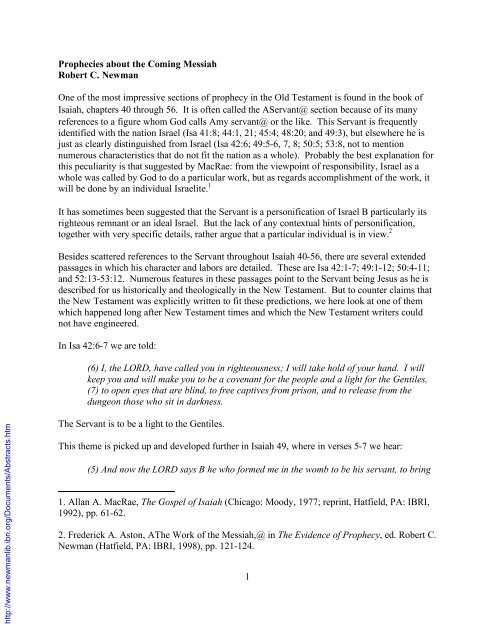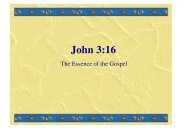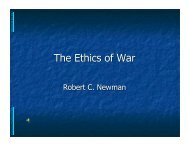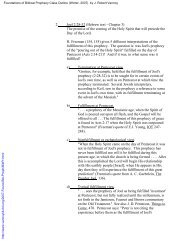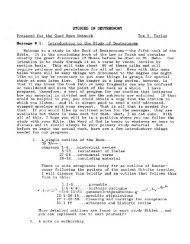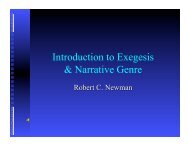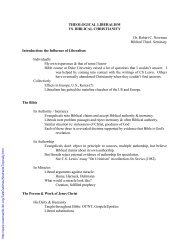1 Prophecies about the Coming Messiah Robert C. Newman One of ...
1 Prophecies about the Coming Messiah Robert C. Newman One of ...
1 Prophecies about the Coming Messiah Robert C. Newman One of ...
Create successful ePaper yourself
Turn your PDF publications into a flip-book with our unique Google optimized e-Paper software.
<strong>Prophecies</strong> <strong>about</strong> <strong>the</strong> <strong>Coming</strong> <strong>Messiah</strong><strong>Robert</strong> C. <strong>Newman</strong><strong>One</strong> <strong>of</strong> <strong>the</strong> most impressive sections <strong>of</strong> prophecy in <strong>the</strong> Old Testament is found in <strong>the</strong> book <strong>of</strong>Isaiah, chapters 40 through 56. It is <strong>of</strong>ten called <strong>the</strong> AServant@ section because <strong>of</strong> its manyreferences to a figure whom God calls Amy servant@ or <strong>the</strong> like. This Servant is frequentlyidentified with <strong>the</strong> nation Israel (Isa 41:8; 44:1, 21; 45:4; 48:20; and 49:3), but elsewhere he isjust as clearly distinguished from Israel (Isa 42:6; 49:5-6, 7, 8; 50:5; 53:8, not to mentionnumerous characteristics that do not fit <strong>the</strong> nation as a whole). Probably <strong>the</strong> best explanation forthis peculiarity is that suggested by MacRae: from <strong>the</strong> viewpoint <strong>of</strong> responsibility, Israel as awhole was called by God to do a particular work, but as regards accomplishment <strong>of</strong> <strong>the</strong> work, itwill be done by an individual Israelite. 1It has sometimes been suggested that <strong>the</strong> Servant is a personification <strong>of</strong> Israel B particularly itsrighteous remnant or an ideal Israel. But <strong>the</strong> lack <strong>of</strong> any contextual hints <strong>of</strong> personification,toge<strong>the</strong>r with very specific details, ra<strong>the</strong>r argue that a particular individual is in view. 2Besides scattered references to <strong>the</strong> Servant throughout Isaiah 40-56, <strong>the</strong>re are several extendedpassages in which his character and labors are detailed. These are Isa 42:1-7; 49:1-12; 50:4-11;and 52:13-53:12. Numerous features in <strong>the</strong>se passages point to <strong>the</strong> Servant being Jesus as he isdescribed for us historically and <strong>the</strong>ologically in <strong>the</strong> New Testament. But to counter claims that<strong>the</strong> New Testament was explicitly written to fit <strong>the</strong>se predictions, we here look at one <strong>of</strong> <strong>the</strong>mwhich happened long after New Testament times and which <strong>the</strong> New Testament writers couldnot have engineered.In Isa 42:6-7 we are told:(6) I, <strong>the</strong> LORD, have called you in righteousness; I will take hold <strong>of</strong> your hand. I willkeep you and will make you to be a covenant for <strong>the</strong> people and a light for <strong>the</strong> Gentiles,(7) to open eyes that are blind, to free captives from prison, and to release from <strong>the</strong>dungeon those who sit in darkness.The Servant is to be a light to <strong>the</strong> Gentiles.This <strong>the</strong>me is picked up and developed fur<strong>the</strong>r in Isaiah 49, where in verses 5-7 we hear:(5) And now <strong>the</strong> LORD says B he who formed me in <strong>the</strong> womb to be his servant, to bring1. Allan A. MacRae, The Gospel <strong>of</strong> Isaiah (Chicago: Moody, 1977; reprint, Hatfield, PA: IBRI,1992), pp. 61-62.2. Frederick A. Aston, AThe Work <strong>of</strong> <strong>the</strong> <strong>Messiah</strong>,@ in The Evidence <strong>of</strong> Prophecy, ed. <strong>Robert</strong> C.<strong>Newman</strong> (Hatfield, PA: IBRI, 1998), pp. 121-124.1
ack Jacob to him and ga<strong>the</strong>r Israel to himself, for I am honored in <strong>the</strong> eyes <strong>of</strong> <strong>the</strong> LORDand my God has been my strength B (6) he says: AIt is too small a thing for you to be myservant to restore <strong>the</strong> tribes <strong>of</strong> Jacob and bring back those <strong>of</strong> Israel I have kept, I willalso make you a light for <strong>the</strong> Gentiles, that you may bring my salvation to <strong>the</strong> ends <strong>of</strong> <strong>the</strong>earth.@ (7) This is what <strong>the</strong> LORD says B <strong>the</strong> Redeemer and Holy <strong>One</strong> <strong>of</strong> Israel B to himwho was despised and abhorred by <strong>the</strong> nation, to <strong>the</strong> servant <strong>of</strong> rulers: AKings will seeyou and rise up, princes will see and bow down, because <strong>of</strong> <strong>the</strong> LORD, who is faithful,<strong>the</strong> Holy <strong>One</strong> <strong>of</strong> Israel, who has chosen you.@Here <strong>the</strong> Servant=s being a light to <strong>the</strong> Gentiles is explained as Abring[ing] my salvation to <strong>the</strong>ends <strong>of</strong> <strong>the</strong> earth,@ suggesting that <strong>the</strong> phrases in Isa 42:7 <strong>about</strong> opening blind eyes and freeingcaptives are ei<strong>the</strong>r eschatological (referring to events at <strong>the</strong> end <strong>of</strong> <strong>the</strong> age) or are spiritual(rescuing people from spiritual blindness and from captivity to sin). But in any case <strong>the</strong>Servant=s work is to have a powerful effect. Though Adespised and abhorred by <strong>the</strong> nation,@even rulers <strong>of</strong> <strong>the</strong> Gentiles will bow down to him.Has <strong>the</strong>re ever been any Israelite that fits <strong>the</strong>se words? Not even Albert Einstein, though he hasreceived widespread honor for his scientific discoveries and has been <strong>the</strong> most respected Jew <strong>of</strong>recent centuries.But what <strong>about</strong> Jesus? He is <strong>the</strong> only Jewish person B and one who claimed to be <strong>the</strong> <strong>Messiah</strong> atthat B who has started a world religion <strong>of</strong> Gentiles. Before <strong>the</strong> first century AD, only <strong>the</strong> Jewsand a few Greek philosophers were believers in one God. Only a small percentage <strong>of</strong> <strong>the</strong>world=s population were even aware <strong>of</strong> <strong>the</strong> Hebrew Scriptures. Most worshiped a wholecommittee <strong>of</strong> gods, who set ra<strong>the</strong>r poor examples for <strong>the</strong>ir followers. The resulting level <strong>of</strong>morality was understandably quite low. But today those who believe in one God include notonly <strong>the</strong> Jews (14.2 million), but also <strong>the</strong> predominantly Gentile Christians (1.4 billion). Wecould also include <strong>the</strong> Muslims (723 million), as <strong>the</strong> rise <strong>of</strong> Islam was at least an indirect result<strong>of</strong> Christianity. Thus <strong>about</strong> one-half <strong>the</strong> world=s population now claims allegiance to <strong>the</strong> God <strong>of</strong>Abraham, most <strong>of</strong> <strong>the</strong>se as a result <strong>of</strong> <strong>the</strong> work <strong>of</strong> Jesus. 3Even neglecting Islam and most Jews, <strong>about</strong> one-third <strong>of</strong> <strong>the</strong> world=s people accept Jesus as <strong>the</strong><strong>Messiah</strong>. They are found on every continent and in nearly every country: both in <strong>the</strong> moredeveloped nations (790 million) and less developed (643 million); in <strong>the</strong> Western nations (547million), <strong>the</strong> Third World (532 million) and even in Communist countries (254 million). 4 TrulyJesus <strong>of</strong> Nazareth has become a light to <strong>the</strong> Gentiles as news <strong>of</strong> him has spread throughout <strong>the</strong>world.3. Statistics from David B. Barrett, World Christian Encyclopedia (New York: Oxford, 1982),pp. 4, 6.4. Ibid.2
Ano<strong>the</strong>r striking prophecy points to <strong>the</strong> time <strong>of</strong> <strong>the</strong> coming <strong>of</strong> <strong>the</strong> <strong>Messiah</strong>. This is <strong>the</strong> prophecy<strong>of</strong> Daniel=s seventy Aweeks@ found in Daniel chapter 9.According to <strong>the</strong> narrative at that point, <strong>the</strong> prophet Daniel has recently come to understand from<strong>the</strong> Scriptures that A<strong>the</strong> desolation <strong>of</strong> Jerusalem would last seventy years.@ Apparently Danielrealizes that <strong>the</strong> time must be <strong>about</strong> up, so he begins to pray to God, confessing his sins and those<strong>of</strong> his people, asking God to restore <strong>the</strong> city for <strong>the</strong> sake <strong>of</strong> his Name. While he is praying, <strong>the</strong>angel Gabriel is sent to him with <strong>the</strong> following message (Dan 9:24-27):(24) Seventy >sevens= are decreed for your people and your holy city to finishtransgression, to put an end to sin, to atone for wickedness, to bring in everlastingrighteousness, to seal up vision and prophecy and to anoint <strong>the</strong> most holy. (25) Knowand understand this: From <strong>the</strong> issuing <strong>of</strong> <strong>the</strong> decree to restore and rebuild Jerusalemuntil <strong>the</strong> Anointed <strong>One</strong>, <strong>the</strong> ruler, comes, <strong>the</strong>re will be seven >sevens,= and sixty-two>sevens.= It will be rebuilt with streets and a trench, but in times <strong>of</strong> trouble. (26) After<strong>the</strong> sixty-two >sevens,= <strong>the</strong> Anointed <strong>One</strong> will be cut <strong>of</strong>f and have nothing. The people <strong>of</strong><strong>the</strong> ruler who will come will destroy <strong>the</strong> city and <strong>the</strong> sanctuary. The end will come like aflood: War will continue until <strong>the</strong> end, and desolations have been decreed. (27) He willconfirm a covenant with many for one >seven.= In <strong>the</strong> middle <strong>of</strong> <strong>the</strong> >seven= he will putan end to sacrifice and <strong>of</strong>fering. And on a wing [<strong>of</strong> <strong>the</strong> temple] he will set up anabomination that causes desolation, until <strong>the</strong> end that is decreed is poured out on him.There has been considerable dispute over <strong>the</strong> meaning <strong>of</strong> this passage, especially since <strong>the</strong> rise <strong>of</strong><strong>the</strong>ological liberalism in which it is claimed that <strong>the</strong> book <strong>of</strong> Daniel was written in <strong>the</strong>Maccabean period (c165 BC) instead <strong>of</strong> <strong>the</strong> sixth century BC in which <strong>the</strong> narrative is set. Threeitems in particular will concern us here: (1) Is <strong>the</strong> passage speaking <strong>of</strong> one Anointed <strong>One</strong> or two?(2) What is <strong>the</strong> unit <strong>of</strong> time measurement used here? (3) What is <strong>the</strong> starting point for <strong>the</strong> timespanhere pictured?Modern translations fall into two classes regarding how to construe <strong>the</strong> syntax <strong>of</strong> verses 25 and26. The King James Version and a number <strong>of</strong> more conservative translations 5 agree with <strong>the</strong>quotation above, in which it appears that <strong>the</strong> prophecy expects one Anointed <strong>One</strong> (or <strong>Messiah</strong>) tocome and be cut <strong>of</strong>f at <strong>the</strong> end <strong>of</strong> 7 + 62 >sevens.= The Revised Standard Version and a number<strong>of</strong> more liberal translations 6 instead read <strong>the</strong> text as saying <strong>the</strong>re will be two Anointed <strong>One</strong>s, onecoming at <strong>the</strong> end <strong>of</strong> seven >sevens,= <strong>the</strong> o<strong>the</strong>r after a fur<strong>the</strong>r sixty-two >sevens=:5. Including <strong>the</strong> NIV, NASB, Living Bible, Berkeley Version, Amplified Bible, and <strong>the</strong>Jerusalem Bible.6. Including <strong>the</strong> Jewish Publication Society=s version, <strong>the</strong> NEB, <strong>the</strong> Smith-Goodspeed andM<strong>of</strong>fatt translations, and <strong>the</strong> New American Bible.3
(25) Know <strong>the</strong>refore and understand that from <strong>the</strong> going forth <strong>of</strong> <strong>the</strong> word to restore andbuild Jerusalem to <strong>the</strong> coming <strong>of</strong> an anointed one, a prince, <strong>the</strong>re shall be seven weeks.Then for sixty-two weeks, it shall be built again with squares and moat, but in a troubledtime. (26) And after <strong>the</strong> sixty-two weeks, an anointed one shall be cut <strong>of</strong>f, and shall havenothing....This latter translation follows <strong>the</strong> old Masoretic punctuation <strong>of</strong> <strong>the</strong> Hebrew Bible, where adivision in <strong>the</strong> sense is made between <strong>the</strong> seven weeks and <strong>the</strong> sixty-two weeks. 7 It does explain<strong>the</strong> peculiar combination <strong>of</strong> 7 and 62 instead <strong>of</strong> <strong>the</strong>ir sum 69.In spite <strong>of</strong> <strong>the</strong>se facts, <strong>the</strong> Masoretic punctuation may not date back before <strong>the</strong> ninth or tenthcentury AD, 8 and <strong>the</strong> parallelism <strong>of</strong> <strong>the</strong> passage favors <strong>the</strong> former translation. In <strong>the</strong> Hebrew, <strong>the</strong>phrase rendered Arestore and rebuild@ consists <strong>of</strong> <strong>the</strong> same pair <strong>of</strong> verbs as are translated Abuiltagain@ later in <strong>the</strong> verse. Likewise <strong>the</strong> word A<strong>Messiah</strong>/Anointed <strong>One</strong>@ is repeated. Thisparallelism may be sketched as follows:From <strong>the</strong> going forth <strong>of</strong> <strong>the</strong> word to build again JerusalemTo <strong>Messiah</strong> <strong>the</strong> Prince shall be 7 weeks and 62 weeks.Plaza and moat shall be built again...And after 62 weeks <strong>Messiah</strong> shall be cut <strong>of</strong>f...This parallelism suggests that <strong>the</strong> passage is structured as a summary statement <strong>of</strong> two lines inwhich two events and two time-periods are mentioned, followed by several lines in which <strong>the</strong>details <strong>of</strong> each event are spelled out in turn. Thus we should expect one <strong>Messiah</strong> or anointedone, whose cutting <strong>of</strong>f occurs after 69 weeks from <strong>the</strong> starting point. Perhaps <strong>the</strong> first sevenweeks, if one may hazard a guess, involve <strong>the</strong> rebuilding <strong>of</strong> <strong>the</strong> city. 9The usual procedure in interpreting this passage is to assume that <strong>the</strong> prophecy intends by <strong>the</strong>word >seven= or >week= a period <strong>of</strong> seven years, and <strong>the</strong>n to proceed to make <strong>the</strong> calculationusing units <strong>of</strong> years. With <strong>the</strong> most likely starting point (<strong>the</strong> one we shall suggest below), thishas <strong>the</strong> anointed one cut <strong>of</strong>f <strong>about</strong> 39 AD. As a result, most conservatives have opted for anearlier starting point or suggested that <strong>the</strong> years are actually >prophetic years= <strong>of</strong> only 360 days.None <strong>of</strong> this is necessary.7. See, for example, K. Elliger and W. Rudolph, Biblica Hebraica Stuttgartensia editio minor(Stuttgart: Deutsche Biblegesellschaft, 1984), p. 1404.8. Ernst Wurtwein, The Text <strong>of</strong> <strong>the</strong> Old Testament (Oxford: Basil Blackwell, 1957), p. 19.9. As suggested in <strong>the</strong> Berkeley Version. The Smith-Goodspeed and <strong>the</strong> New English Bibleimply such an interpretation by translating verse 25b: Afor sixty-two weeks it shall stay rebuilt /remain restored,@ but <strong>the</strong>se translations <strong>of</strong> <strong>the</strong> verb shub find no warrant in <strong>the</strong> lexicons andmerely show <strong>the</strong> problem <strong>of</strong> adopting <strong>the</strong> Masoretic punctuation.4
The unit <strong>of</strong> measurement used here in Daniel is <strong>the</strong> >week= or >seven,= not <strong>the</strong> year. Thecontext, and possibly <strong>the</strong> unusual plural used for this word here, suggests that <strong>the</strong> author intendsus to understand <strong>the</strong> seven-year sabbatical land-use cycle ra<strong>the</strong>r than <strong>the</strong> seven-day week. 10 Thebiblical commands regarding this sabbatical cycle are given in Exodus 23:10-11 and Leviticus25:3-7, 18-22. The Exodus passage reads: AFor six years you are to sow your fields and harvestyour crops, but during <strong>the</strong> seventh year let <strong>the</strong> land lie unplowed and unused.@It is interesting that our context in Daniel 9 seems to point to this usage as well. Daniel has beenconcerned <strong>about</strong> <strong>the</strong> desolation <strong>of</strong> Jerusalem and <strong>the</strong> fact that <strong>the</strong> Israelites are scattered from<strong>the</strong>ir land. He has just learned Afrom books@ that this desolation will last seventy years. Theprophecy <strong>of</strong> Jeremiah supplies <strong>the</strong> time-element for this scattering and desolation (Jer 25:11-12;29:10), but it appears that Lev 26:32-35 supplies <strong>the</strong> rationale: If Israel did not keep <strong>the</strong>sabbatical-year regulation, God would expel <strong>the</strong>m from <strong>the</strong> land until <strong>the</strong> land could Aenjoy itssabbaths.@ 11Various suggestions have been made for <strong>the</strong> starting point <strong>of</strong> <strong>the</strong>se seventy >sevens=: (1) God=sword at <strong>the</strong> fall <strong>of</strong> Jerusalem (586 BC; Jer 25:11-12; 29:10); (2) Cyrus= word in allowing <strong>the</strong>captives to return to Jerusalem (537 BC; 2 Chron 36:23; Ezra 1:2); (3) Artaxerxes= commissionto Ezra (458 BC; Ezra 4:11-12, 23); (4) Artaxerxes= commission to Nehemiah (445 BC; Neh2:1-6). 12 Of <strong>the</strong>se four, only <strong>the</strong> last actually issued in <strong>the</strong> rebuilding <strong>of</strong> <strong>the</strong> city wall. In thusmaking Jerusalem fortified again, it became in ancient parlance once more a city and no longer avillage. We thus follow this fourth alternative, and Neh 2:1 dates Artaxerxes= sending Nehemiahto Jerusalem to <strong>the</strong> twentieth year <strong>of</strong> Artaxerxes 1, namely 445 BC. 13 So this is our startingpoint.Now we must make <strong>the</strong> calculation forward from 445 BC. But unlike many o<strong>the</strong>rs, we shall use<strong>the</strong> actual sabbatical cycles as units <strong>of</strong> measurement ra<strong>the</strong>r than just adding 7 x 69 years to <strong>the</strong>starting point, since this follows <strong>the</strong> actual usage in Daniel. Recent work by Ben Zion10. Francis Brown, S. R. Driver and C. A. Briggs, A Hebrew and English Lexicon <strong>of</strong> <strong>the</strong> OldTestament (Oxford: Clarendon, 1966): 988-989; Ludwig Koehler and Walter Baumgartner, TheHebrew and Aramaic Lexicon <strong>of</strong> <strong>the</strong> Old Testament 5 vols. (Leiden: Brill, 1994-2000), 4:1383-1384.11. The author <strong>of</strong> 2 Chron 36:21 explicitly applies this reasoning to explain <strong>the</strong> length <strong>of</strong> <strong>the</strong>Babylonian captivity.12. See J. Barton Payne, Encyclopedia <strong>of</strong> Biblical Prophecy (New York: Harper and Row, 1973),pp. 383-386.13. Jack Finegan, Handbook <strong>of</strong> Biblical Chronology (Princeton: Princeton University Press,1964), section 336.5
Wacholder has reviewed all <strong>the</strong> ancient data for <strong>the</strong> location <strong>of</strong> <strong>the</strong> sabbatical cycles in antiquity,and he finds <strong>the</strong> modern cycle in error by one year. 14 We will use Wacholder=s numbers ra<strong>the</strong>rthan <strong>the</strong> traditional cycles, but this will turn out to make no difference in our result.The calculation is very simple. Our starting point, 445 BC, falls in <strong>the</strong> seven-year cycle 449-442BC, <strong>of</strong> which <strong>the</strong> last year, from September 443 to September 442, is <strong>the</strong> seventh or sabbaticalyear. Using <strong>the</strong> usual Jewish inclusive method <strong>of</strong> counting, 449-442 is <strong>the</strong> first >seven= <strong>of</strong>Daniel=s prophecy. The second is 442-435 BC, and so on, down to <strong>the</strong> transition from BC toAD, where we need to remember that 1 BC is immediately followed by AD 1, with no zero inbetween. The 69 th cycle following Artaxerxes= commission is AD 28-35, just <strong>the</strong> time that Jesus<strong>of</strong> Nazareth was Acut <strong>of</strong>f@ in Palestine while claiming to be God=s <strong>Messiah</strong>!BCAD449-442 442-435 435-428 14-21 21-28 28-351st 2nd 3rd 67th 68th 69th^ 445 - Artaxerxes= decree Jesus= crucifixion - 30 +Some may be concerned that Daniel says Aafter <strong>the</strong> sixty-two >sevens= <strong>Messiah</strong> will be cut<strong>of</strong>f,@ whereas by our calculation <strong>the</strong> crucifixion occurs on <strong>the</strong> 62 nd >seven= (<strong>the</strong> 69 th , counting<strong>the</strong> first 7). But this, too, is a conventional Jewish idiom, in which Aafter@ means Aafter <strong>the</strong>beginning <strong>of</strong>.@ Notice that Jesus= resurrection is alternatively spoken <strong>of</strong> as occurring Aafterthree days@ (Matt 27:63; Mark 8:31) and also Aon <strong>the</strong> third day@ (Matt 20:19; Mark 9:31).If instead we follow <strong>the</strong> traditional scheme for <strong>the</strong> location <strong>of</strong> <strong>the</strong> sabbatical cycles instead <strong>of</strong>Wacholder=s, <strong>the</strong> 69 th cycle only shifts by one year, to AD 27-34, which still fits equally well.Likewise an error by a year or two on ei<strong>the</strong>r end B for Artaxerxes= 20 th year or <strong>the</strong> date <strong>of</strong> <strong>the</strong>crucifixion B would not change <strong>the</strong> result. The prediction fits Jesus even allowing for <strong>the</strong> largestpossible uncertainties in chronology!How unusual are <strong>the</strong>se predictions? We here attempt some estimation <strong>of</strong> probabilities.The ALight to <strong>the</strong> Nations@ prophecy, in <strong>the</strong> course <strong>of</strong> over 2000 years since it was made, hasbeen fulfilled in a ra<strong>the</strong>r spectacular manner. The largest religion in <strong>the</strong> world today was14. Ben Zion Wacholder, AThe Calendar <strong>of</strong> Sabbatical Cycles During <strong>the</strong> Second Temple and<strong>the</strong> Early Rabbinic Period,@ Hebrew Union College Annual 44 (1973):153-196. A completetable from 519 BC to AD 441 is given on pp. 185-196.6
founded by a Jew, who has turned multitudes <strong>of</strong> pagan Gentiles into worshipers <strong>of</strong> <strong>the</strong> God <strong>of</strong>Abraham. How do we calculate <strong>the</strong> probability <strong>of</strong> something like this happening? We may, Ithink, assume that <strong>the</strong> founder <strong>of</strong> <strong>the</strong> world=s largest religion must belong to some people group.Then what fraction <strong>of</strong> <strong>the</strong> world=s population, at <strong>the</strong> time <strong>the</strong> prediction was made, or <strong>the</strong> time itwas fulfilled, were Jews? The current fraction <strong>of</strong> Jews in <strong>the</strong> world is .3%. In spite <strong>of</strong> <strong>the</strong>holocaust, <strong>the</strong> fraction <strong>of</strong> Jews living today is probably higher than in antiquity, since <strong>the</strong> Jewshave participated in <strong>the</strong> huge population expansion <strong>of</strong> first world countries and many ethnicgroups have not. But we will stick with .3%. Thus <strong>the</strong>re is antecedently <strong>about</strong> 1 chance in 300that this prophecy will come true.What fraction <strong>of</strong> famous Jews would be Adespised and abhorred by <strong>the</strong> nation@ (Isa 49:7)? Nota very large fraction normally. Like any ethnic group, Jews tend to take pride in those who havedone well in <strong>the</strong> larger society. Of course, Jesus is viewed as a religious innovator, and <strong>the</strong>fraction <strong>of</strong> Jewish religious innovators who are abhorred by <strong>the</strong> Jews is doubtless closer to onethan in non-religious cases. But are Spinoza and Einstein abhorred by <strong>the</strong> nation? Anyway <strong>the</strong>prophecy doesn=t say he will be a religious innovator, and one <strong>of</strong> <strong>the</strong> standard objections against<strong>the</strong> <strong>Messiah</strong>ship <strong>of</strong> Jesus is his rejection by <strong>the</strong> Jews! I think <strong>the</strong>re is something unusual goingon here, and I incline to give this one chance in ten. Total probability on Alight to <strong>the</strong> nations,@1 in 3000.How <strong>about</strong> Daniel=s seventy weeks prophecy? What is <strong>the</strong> chance that <strong>the</strong> prophet willaccidently hit Jesus at a distance <strong>of</strong> hundreds <strong>of</strong> years? The size <strong>of</strong> his Agunsight@ is sevenyears. The size <strong>of</strong> <strong>the</strong> prophetic span given is 490 years. <strong>One</strong> chance in 70. But <strong>the</strong>re is noantecedent reason why <strong>the</strong> prophet need limit himself to 490 years in <strong>the</strong> sweep <strong>of</strong> his prophecy.If we took instead <strong>the</strong> length <strong>of</strong> Jewish history up to <strong>the</strong> time <strong>of</strong> fulfilment, that would be <strong>about</strong>1500 years (from Moses) or 2000 years (from Abraham), one chance in 200 or 1 in 300. If wetook <strong>the</strong> length <strong>of</strong> Jewish history to date, <strong>about</strong> 1 in 500 to 1 in 600. Let=s try 1 in 200.Compare this with <strong>the</strong> liberal alternative that says some pseudo-Daniel was Apredicting@ <strong>the</strong>Maccabean persecution after <strong>the</strong> fact using one <strong>of</strong> <strong>the</strong> starting points mentioned above. Taking<strong>the</strong> target to be 170 BC and <strong>the</strong> seventy weeks to be 490 years, <strong>the</strong> starting point would be 660BC, which misses <strong>the</strong> four alternative starting points listed on page 5 as follows: (1) by 70 years,(2) by 120, (3) by 190, and (4) by 215 years! This is one <strong>of</strong> <strong>the</strong> reasons that convinced me thatcritical B Humean B biblical scholarship is bankrupt.There are o<strong>the</strong>r impressive Messianic prophecies. The prediction <strong>of</strong> <strong>the</strong> suffering servant inIsaiah 53 (actually 52:13-53:12) comes to mind. See <strong>the</strong> detailed discussions in Aston andMacRae. 15 Aston finds <strong>the</strong> following features in this passage. (1) The suffering servant is15.Frederick A. Aston, AThe Work <strong>of</strong> <strong>the</strong> <strong>Messiah</strong>,@ in The Evidence <strong>of</strong> Prophecy, ed. <strong>Robert</strong>C. <strong>Newman</strong> (Hatfield, PA: Interdisciplinary Biblical Research Institute, 1988), pp 119-127;Allan A. MacRae, The Gospel <strong>of</strong> Isaiah (Chicago: Moody, 1977; reprint Hatfield, PA:Interdisciplinary Biblical Research Institute, 1992), pp 129-150.7
portrayed in detailed features as a real person. (2) He is an innocent sufferer. (3) He is avoluntary sufferer. (4) He is an obedient, humble and silent sufferer. (5) His suffering springsfrom love for sinners, including his executioners, who act in ignorance. (6) His suffering isforeordained by God in love, and fulfills <strong>the</strong> divine intention and purpose. (7) His suffering isvicarious or substitutionary. (8) His suffering is redemptive and spiritual in nature. (9) Hissuffering ends in death. (10) His death gives way to resurrection. (11) His atoning work leads<strong>the</strong> straying people to confession and repentance. (12) His redemptive work inaugurates avictorious life <strong>of</strong> kingly glory. Obviously, many <strong>of</strong> <strong>the</strong>se features refer to phenomena whichcannot be directly seen in human history. But what is clear is that <strong>the</strong>y are central to <strong>the</strong> NewTestament portrayal <strong>of</strong> Jesus, <strong>the</strong> one Messianic claimant who has founded a world religion <strong>of</strong>Gentiles and who was cut <strong>of</strong>f in just <strong>the</strong> period designated by Daniel! What are <strong>the</strong> chances thatall <strong>the</strong>se things could plausibly be applied to an individual who also shows up at <strong>the</strong> right timeand does <strong>the</strong> right things? Can you specify even one o<strong>the</strong>r candidate in <strong>the</strong> first century AD? Orin any century? Surely <strong>the</strong> probability for this is far smaller than 1 in a thousand.Then <strong>the</strong>re is <strong>the</strong> suffering person depicted in Psalm 22, whose cry to God for help is reported bytwo <strong>of</strong> <strong>the</strong> Gospel writers to have been shouted by Jesus from <strong>the</strong> cross. This person (1) feelsabandoned by God but (2) trusts him completely. (3) He is despised and mocked by <strong>the</strong> peoplewho surround him. (4) They have pierced his hands and feet, (5) cast lots for his clothing, (6)and subjected him to some situation in which he is weak, terribly thirsty, and his bones are out <strong>of</strong>joint. (7) Although he is Alaid in <strong>the</strong> dust <strong>of</strong> death,@ God somehow rescues him. (8) The effects<strong>of</strong> <strong>the</strong>se events will go down through <strong>the</strong> future generations and to <strong>the</strong> ends <strong>of</strong> <strong>the</strong> earth, (9) sothat all <strong>the</strong> families <strong>of</strong> <strong>the</strong> nations will turn to <strong>the</strong> Lord and bow down to him. Though some <strong>of</strong><strong>the</strong>se features are regularly dismissed from being real fulfillments by assuming that <strong>the</strong> Gospelwriters ransacked this passage for details to use in describing Jesus= death, it remains a fact thatthis passage strikingly fits death by crucifixion, an experience that Jesus certainly endured. Whatfraction <strong>of</strong> people since this Psalm was written have died by a death consistent with <strong>the</strong>sedetails? <strong>One</strong> in a thousand? <strong>One</strong> in a million?So, to summarize <strong>the</strong> probabilities:Light to <strong>the</strong> nations (Isaiah 42 & 49): 1 in 3000Seventy weeks prophecy (Daniel 9): 1 in 200Suffering servant (Isaiah 53): 1 in 1000Abandoned by God (Psalm 22): 1 in 1000Cumulative probability 1 in 600,000,000,0001 in 600 trillion!I have no fear <strong>of</strong> entrusting my destiny to Jesus and his claims!8


